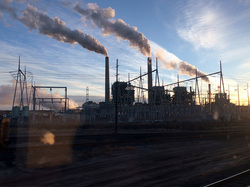
A quick look at a map provided by the Edison Electric Institute shows Utahns, on average, paid 9.98 cents per kilowatt-hour in 2012, among the nation’s lowest rates. But then, the map also shows that other states with coal are in the same company. A narrow swath from Louisiana through Kentucky has lower rates than Utah.
They can kiss it goodbye, too.
| | Utahns used to lament that some of the most abundant, efficient and clean coal in the world — the stuff hidden just beneath the Kaiparowits Plateau in Southern Utah — was locked up in one fell swoop when President Clinton made it a part of the massive Grand Staircase-Escalante Monument. Now those worries seem so 20th century. Today, coal is even less politically correct than the high fructose corn syrup in that big drink you like to buy — the one some states are thinking about sticking a warning label on even as they let marijuana cigarettes roam free. President Obama made it even more so this week when he presented a new EPA plan for clean power. By 2030, states will have to find a way to cut greenhouse gas emissions by 30 percent over levels that existed in 2005, the peak year. The power industry estimates this means about one-third of the 1,000 existing coal-fired plants will cease to exist. Those plants currently provide about 40 percent of the electricity that powers the nation. The problem is, when it comes to staying warm in the winter and cool in the summer, not to mention powering up those electronic devices we obsess over or keeping those hybrid cars running, there aren’t many alternatives. Nuclear power? Getting the permits to build such a plant takes a good chunk of a lifetime, and that’s if you can get around the protests. Renewables such as solar and wind and water? These are popular alternatives, but they currently provide only about 12 percent of the nation’s needs combined, according to the U.S. Energy Information Administration. Natural gas? This is, in fact, a good alternative, but it will involve “fracking,” a controversial drilling method that drives environmentalists crazy. But even if you can get around that, only a few coal plants can be converted to natural gas. Others will have to be shut down and replaced, and that costs money — and that will raise your rates. So the days of cheap energy are numbered, which may not be the best news just after the Commerce Department surprised us with news that the U.S. economy contracted by 1 percent during the first quarter. The president’s announcement had another curious twist to it. Other than Utah, most of those other states with coal have one other thing in common — they tend to vote for Democrats. With control of the Senate up for grabs this November, Democratic candidates from West Virginia to Alaska seemed to be falling all over each other this week to get as far away from the president as possible. Obama clearly has made a different calculation. Even in Utah, people have a love-hate relationship with environmental regulations. We hate being told what to do by Washington, but we love to breathe clean air. If there was one issue that moved Utahns to become politically engaged last winter, it was air quality, something that seems in short supply along the Wasatch Front in the winter. The Obama administration said the new rules would prevent up to 150,000 cases of asthma in children, prevent up to 3,300 heart attacks and up to 2,800 hospital admissions. Those numbers are impossible to verify, but many people in these parts know the effects of bad air first-hand. Utah’s coal-fired plants are too far from the Wasatch Front to affect winter air. But the combined impact on air nationwide shouldn’t be discounted. For many Americans, however, it’s the process that rankles. Rates will rise, but that probably would happen anyway (although it bears noting that the poor will suffer the most.) But the people’s representatives in Washington, the ones we elect to make decisions affecting our lives, had nothing to say about this. If it’s dictated to us, it isn’t our plan. |

 RSS Feed
RSS Feed

